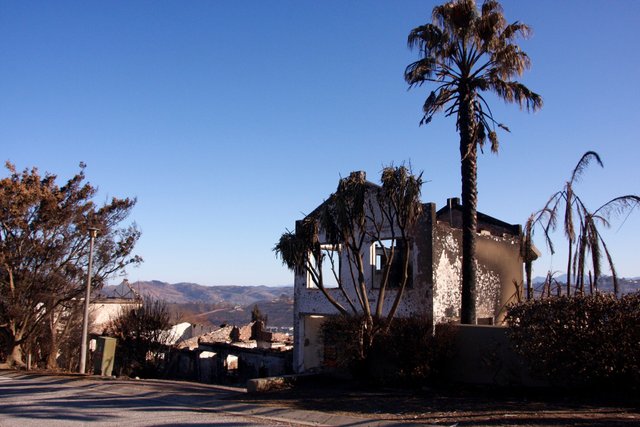Garden town rises like a Phoenix from the ashes
Knysna is one of the prettiest towns on South Africa’s Garden Route, which runs along part of the country’s South Coast. But it was a sad picture that met me when I arrived there a while back.
I haven’t been Steeming for some time, which is largely due to my move from South Africa’s industrial heart of Johannesburg to the languid coastal town. I arrived there two weeks after the wild fire that swept through the region on 7 June.
It was a horrid sight. The name Knysna means ferns in the now practically extinct indigenous Koi language. But scorched hills and skeletal tree trunks were all that remained of the plantations of exotics like pine and eucalyptus and the lush tracts of fynbos, as the region’s variety of indigenous shrubs and dainty ferns are known that cover the hills and valleys.

Ruins are all that remain of a house that used to enjoy panoramic views of the Knysna estuary.
The deep indigenous forests, for which the region is renowned and which offer trails that meander between ancient trees, withstood the inferno well.
The business part of town was relatively unscathed too. Not so the hillside suburbs. Over the weeks following my arrival I heard how, on that terrible day of June 7, residents were evacuated to the shores of the estuary around which the town had taken shape over the past nearly two-hundred years.
Some had managed to grab a few things. Others got away with only the clothes they were wearing as smoke and flames, driven by high winds, engulfed the surrounding hills. On returning home the next day, many found only heaps of ash and mangled iron where their houses used to be.
In some places entire street blocks had been wiped out. Elsewhere one house would be left miraculously standing while those around it were gone, apparently as a result of the way the flames would suck up the oxygen, causing the fire to extinguish itself. There were cases where the flames had leaped clean across several rows of houses to pick out one or two further away for incineration.
It was as if some diabolical lottery had played out during those long hours.

The desolate sight of what once was home.
Many residents were left destitute. The sense of loss cut deep and will no doubt linger. But over the weeks I have also seen how the town started to pick itself up again.
Tourism is its lifeblood, and a priority was to keep the industry going. Prospective visitors had to know that it was open for business much as usual.
The estuary was still there, offering its many forms of water sports and pleasure cruises. Whale-spotting was still offered, as were cycling routes and adventure trails through the forests.
They could still enjoy the spectacular sight of the tide pushing through the gap in the hills called The Heads to steadily turn the estuary into a single expanse of water as stretches of shallow islands get inundated, before ebbing back into the Indian Ocean and uncovering the islands for birds to swoop down and feast on the bounty left behind by the receding waters.
One of the main attractions affected by the fire was The Featherbed Restaurant and Nature Reserve on the lagoon’s far shore from town where visitors used to get ferried by a variety of leisure boats, including an old-style paddle vessel appropriately named Paddle Cruiser. But the operators were hopeful that the restaurant would be rebuilt and the reserve sufficiently recovered to receive visitors again by Christmas time.
The Featherbed got its name from the old sailors who escaped rough seas by risking the perilous passage through The Heads to get to the safety of the nook where the lagoon’s gentle swell reminded them of a featherbed.

The rugged beauty of The Heads where the Indian Ocean opens into the Knysna estuary.
To underscore Knysna’s readiness to receive visitors the town’s tourism agency designed an emblem of a bird in the bright-green colours and shape of the beautiful Knysna Loerie, also known as a Turaco, rising like a Phoenix from the ashes. At the top it says Visit Knysna, and at the bottom, Knysna Rising. It appears on a signboard on the Main Road where passersby cannot miss it.

Knysna Tourism head Elmay Bouwer poses with the emblem depicting a bird in the shape and colours of the Knysna lourie (or Turaco) rising like a Phoenix from the ashes.
Nice post. Really enjoyed reading it even if it is such a tragic event. Great to see you posting again
Thanks
A wonderful update on the area, amazing how people all talk about the event when it happens. Few venture back to see the hard work going into the town being taken from destitution into life again @lmar
Thanks.
One of the best places in South Africa thank you for sharing.
Wow, I didn't know about the wildfire. A friend of mine has been there a few times and always talks about how beautiful it is there. I really hope they build back up soon...